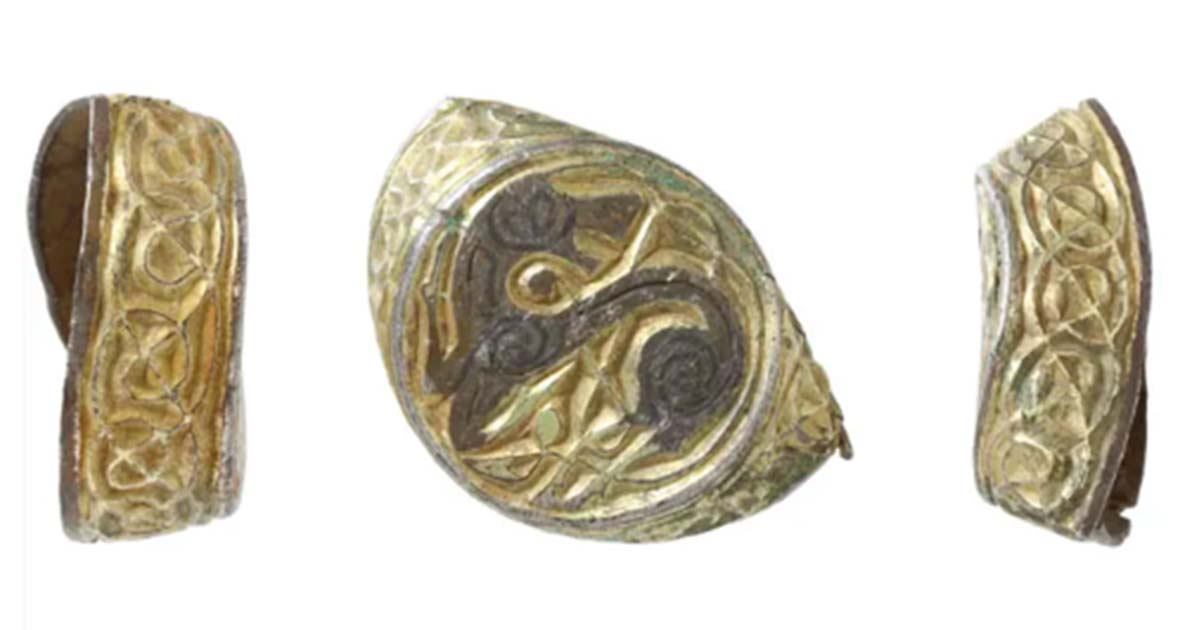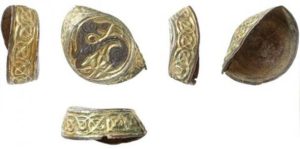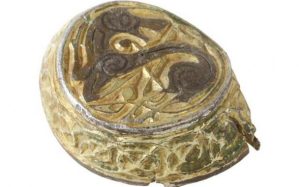Magnificent Silver-Gilded Anglo-Saxon Relic Discovered Confounds Scholars

A stunningly crafted and gilded silver Anglo-Saxon artifact, skillfully made by someone with a keen sense of beauty, has left experts puzzled as to its purpose and utility. This exquisite artifact, measuring just 19.4mm (0.7in) in diameter and displaying a slightly crumpled appearance, was unearthed by a metal detectorist in the vicinity of Langham, Norfolk.
Mystery Anglo-Saxon Artifact: Horse-like Animal Carving
It features a flat, circular top and short, with straight sides that give rise to a shallow, hollow cylinder. Dr. Helen Geake, Norfolk’s finds liaison officer, emphasized that this item, dating back to the late 8th or early 9th century, is “completely unlike” any of the other objects of a similar nature uncovered by detectorists, having distinct design and characteristics, reports The BBC.

Anglo-Saxon Grave Found Holding Royal Treasures
Whatever Happened to Blackbeard’s Silver-Plated Skull?
3 angles of the Anglo-Saxon artifact. Specialists theorize that the design portrays an animal, potentially a horse. (ANDREW WILLIAMS/NORFOLK COUNTY COUNCIL)
“It’s so tiny and yet it was created just as carefully as something like a Bible or piece of jewelry. On the sides is a spiral pattern recognizable from the Book of Kells or Lindisfarne Gospel. It has got a backward-looking animal – possibly a horse – that fills the space nicely and I love its color. A lot of the time we don’t see the colors of the past because clothes don’t survive and enamels drop out of settings,” explained Geake.
The precise purpose remains a subject of debate, with various speculations suggesting it could have served as jewelry, a fragment of clothing, or possibly even a component of a knife.
The Legacy of Armenia: Trade, Metallurgy, and Forging of Precious Metals of the Ancient World
Metals in Bronze Age Weapons Discovered in Sweden Came from Distant Lands
Incredible Craftsmanship and Sophistry
The crafting technique employed – a method known as gilding – is a highly sophisticated process. Here, mercury was skillfully mixed with powdered gold to accentuate the design.
In describing the creator, Dr. Helen Geake suggested that the craftsman must have been remarkably multi-talented, engaging in a diverse range of skills. Whether this remarkable piece was intended for a specific function, such as potentially being the ornamentation for the end of a staff (long since decayed), the creation of this artifact undoubtedly involved a considerable amount of highly skilled craftsmanship.

The enigmatic item was discovered in a crumpled state, yet it maintains a round shape with shallow sides, creating a dish-like form. (ANDREW WILLIAMS/NORFOLK COUNTY COUNCIL)
The artisan responsible for crafting this artifact would have skillfully blended imported mercury from Spain with powdered gold at a significant expense, reports Arkeonews. But this served to enhance the intricacies of the animal depicted within the design. Considering this, it’s likely that this remarkable piece served as an item of jewelry or ornamentation during its era.
Similar designs have been unearthed in the past, but unfortunately, any organic material that might have offered clues to their purpose has long since deteriorated. Dr. Helen Geake has proposed the intriguing possibility that these objects might have adorned the summits of staffs, now decomposed over time.
Norfolk: A Historically Rich Region
The rich archaeological landscape of Norfolk consistently yields a wealth of artifacts. In 2022, official statistics confirmed Norfolk as the leading county in the UK for treasure finds, with the coroner’s office declaring 98 discoveries as legally treasure.

Norfolk region, England. (okrasiuk/Adobe Stock)
This region’s historical significance is further underscored by the discovery of the largest collection of Anglo-Saxon gold coins, dated to the 6th and 7th centuries, ever found in England, a trove unearthed over several decades in a field in west Norfolk, reports The Telegraph.
The artifact has received official recognition as a treasure by a coroner. The Norwich Castle Museum has shown keen interest in acquiring it to enrich their collection